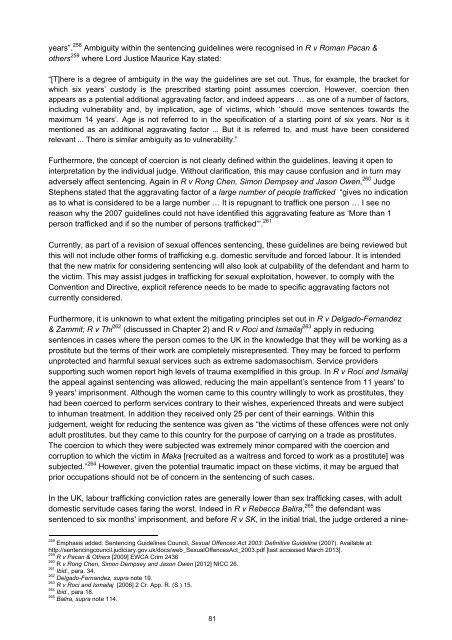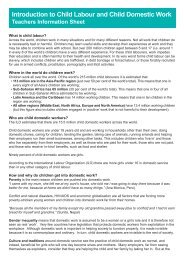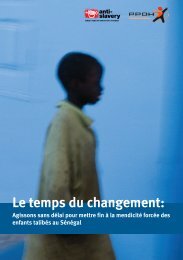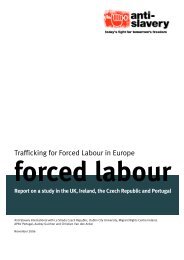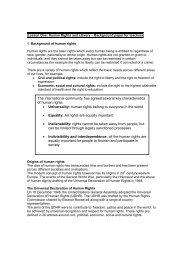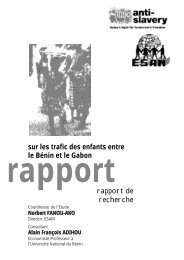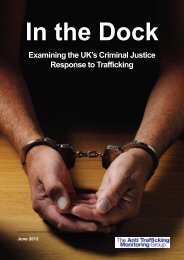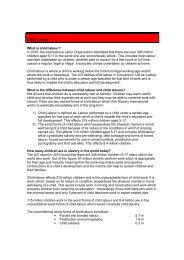are ten countries with potentially higher maximum sentences including: Belgium (20 years), Cyprus(20 years), Czech Republic (18 years), France (20 Years), Hungary (life imprisonment), Ireland (lifeimprisonment), Italy (20 years), <strong>the</strong> Ne<strong>the</strong>rlands (18 years), Romania (25 years) and Slovakia (25years). Also just over half of <strong>the</strong> EU countries set minimum sentences which is higher than <strong>the</strong> sixmonths in <strong>the</strong> UK. Therefore, it can be argued, that <strong>the</strong> current sentencing framework complies with<strong>the</strong> Convention, as it correlates well to most countries and <strong>the</strong> Directive, and it exceeds <strong>the</strong> prescribedmaximum sentences i.e. 14 years as opposed to 10 years maximum sentence. However, someparticipants questioned whe<strong>the</strong>r a maximum of 14 years’ imprisonment reflected <strong>the</strong> true seriousnessof trafficking as an offence when rape and Class A drug trafficking offences attract life imprisonment.<strong>In</strong>deed, it was reported that between 2006 and 2010, “<strong>the</strong> average determinate custodial sentencelength for trafficking for sexual exploitation was 50 months; in <strong>the</strong> case of trafficking for forced labour,it was 51 months, and in <strong>the</strong> case of drug trafficking, it was 73.5 months.” 254<strong>In</strong> practice, <strong>the</strong> actual sentences imposed for trafficking offences rarely reflect <strong>the</strong> maximum sentenceof 14 years’ imprisonment in <strong>the</strong> UK. One judge explained <strong>the</strong> difference between <strong>the</strong> potentialmaximum sentence and sentences imposed:“[I]n <strong>the</strong>ory [sentences as prescribed in legislation] are effective, proportionate and dissuasive because <strong>the</strong>statute accepts this, but <strong>the</strong> [sentencing guidelines] are so wide it is matter for judicial discretion, in practicenone of those [effective, proportionate and dissuasive] are true”.Annex II provides an overview of trafficking prosecutions and convictions since 2009 until early 2013.While <strong>the</strong>re is no consistency shown across <strong>the</strong> board, <strong>the</strong> table shows that longer sentences resultfrom guilty verdicts passed on a number of serious offences on <strong>the</strong> indictment, and where sentencesare imposed consecutively. 255 Despite this <strong>the</strong>re have been cases where trafficking alone or whencoupled with prostitution-related offences resulted in sentences reaching around double figures. <strong>In</strong>particular, see sentences imposed on: 2009 - Tafil Kadria (13 years) and Xhevdet Cikaj (12 years);2010 - Martin Brusch (8 years) and Dusan Horvat (8 years); 2010 - Joszef Budai (8 years) and AndreaNovak (8 years); 2011 Bogdan Nejloveanu (9 years); 2011 - Sergey Konart (10 years); 2012 - IonutDaniel Nicolae (10.5 years) and Vasillica Cosmina Tirei (9 years). Several cases were referred to <strong>the</strong>Court of Appeal by <strong>the</strong> Attorney General under <strong>the</strong> unduly lenient sentencing regime indicating that,as <strong>the</strong> initial sentences were low, some judges’ approach to sentencing traffickers is inappropriate andtrafficking as a crime may be misunderstood by <strong>the</strong> judiciary. An example of this can be found in R vBogdan & Marius Nejloveanu, 256 where Bogdan Nejloveanu’s sentence was increased from 6 years to9 years on appeal. However, it should be noted that some sentences have also been decreased suchas in R v Martin Brusch and Dusan Hurvat, 257 which saw sentences of 10 years decreased to 8 years.Participants cited <strong>the</strong> lack of clear and specific guidance as an explanation for inconsistency insentencing. Whilst <strong>the</strong> Sentencing Guidelines Council (SGC) issued guidelines on <strong>the</strong> SexualOffences Act 2003 in 2007, no sentencing guidelines were produced for labour trafficking (see below).Fur<strong>the</strong>rmore, <strong>the</strong> aggravating factors prescribed by <strong>the</strong> Convention and <strong>the</strong> Directive such asorganised criminal groups or trafficking by public officials are not explicitly recognised in <strong>the</strong> guidelinesproduced for sexual offences. The only guiding principle in this guidance is in PART 6D: Traffickingparagraph 8 which states, “aggravating factors such as participation in a large-scale commercialenterprise involving a high degree of planning, organisation or sophistication, financial or o<strong>the</strong>r gain,and <strong>the</strong> coercion and vulnerability of victims should move sentences towards <strong>the</strong> maximum 14254Crispin Blunt, HC Deb 13 Sep 2011, c887.255Consecutive sentences are served one after <strong>the</strong> o<strong>the</strong>r - e.g. a 6-month sentence followed by a 3-month sentence.256R v Bogdan & Marius Nejloveanu, at Manchester Crown Court, 26 January 2011. The two defendants who were sentenced to 6years’ which was seen a unduly lenient by Attorney General and increased to nine years (for conspiracy to trafficking for sexualexploitation into <strong>the</strong> UK and controlling prostitution) and 21 years’ respectively, which was increased to an <strong>In</strong>determinate Sentencewith 10 year and six months minimum (for four rapes, conspiracy to trafficking for sexual exploitation into <strong>the</strong> UK, assault, causing aperson to engage in sexual activity without consent, controlling prostitution).257R v Martin Brusch and Dusan Hurvat [2012] 1 Cr. App. R. (S) 47.80
years”. 258 Ambiguity within <strong>the</strong> sentencing guidelines were recognised in R v Roman Pacan &o<strong>the</strong>rs 259 where Lord Justice Maurice Kay stated:“[T]here is a degree of ambiguity in <strong>the</strong> way <strong>the</strong> guidelines are set out. Thus, for example, <strong>the</strong> bracket forwhich six years’ custody is <strong>the</strong> prescribed starting point assumes coercion. However, coercion <strong>the</strong>nappears as a potential additional aggravating factor, and indeed appears … as one of a number of factors,including vulnerability and, by implication, age of victims, which ‘should move sentences towards <strong>the</strong>maximum 14 years’. Age is not referred to in <strong>the</strong> specification of a starting point of six years. Nor is itmentioned as an additional aggravating factor ... But it is referred to, and must have been consideredrelevant ... There is similar ambiguity as to vulnerability.”Fur<strong>the</strong>rmore, <strong>the</strong> concept of coercion is not clearly defined within <strong>the</strong> guidelines, leaving it open tointerpretation by <strong>the</strong> individual judge. Without clarification, this may cause confusion and in turn mayadversely affect sentencing. Again in R v Rong Chen, Simon Dempsey and Jason Owen, 260 JudgeStephens stated that <strong>the</strong> aggravating factor of a large number of people trafficked “gives no indicationas to what is considered to be a large number … It is repugnant to traffick one person … I see noreason why <strong>the</strong> 2007 guidelines could not have identified this aggravating feature as ‘More than 1person trafficked and if so <strong>the</strong> number of persons trafficked’”. 261Currently, as part of a revision of sexual offences sentencing, <strong>the</strong>se guidelines are being reviewed butthis will not include o<strong>the</strong>r forms of trafficking e.g. domestic servitude and forced labour. It is intendedthat <strong>the</strong> new matrix for considering sentencing will also look at culpability of <strong>the</strong> defendant and harm to<strong>the</strong> victim. This may assist judges in trafficking for sexual exploitation, however, to comply with <strong>the</strong>Convention and Directive, explicit reference needs to be made to specific aggravating factors notcurrently considered.Fur<strong>the</strong>rmore, it is unknown to what extent <strong>the</strong> mitigating principles set out in R v Delgado-Fernandez& Zammit; R v Thi 262 (discussed in Chapter 2) and R v Roci and Ismailaj 263 apply in reducingsentences in cases where <strong>the</strong> person comes to <strong>the</strong> UK in <strong>the</strong> knowledge that <strong>the</strong>y will be working as aprostitute but <strong>the</strong> terms of <strong>the</strong>ir work are completely misrepresented. They may be forced to performunprotected and harmful sexual services such as extreme sadomasochism. Service providerssupporting such women report high levels of trauma exemplified in this group. <strong>In</strong> R v Roci and Ismailaj<strong>the</strong> appeal against sentencing was allowed, reducing <strong>the</strong> main appellant’s sentence from 11 years' to9 years' imprisonment. Although <strong>the</strong> women came to this country willingly to work as prostitutes, <strong>the</strong>yhad been coerced to perform services contrary to <strong>the</strong>ir wishes, experienced threats and were subjectto inhuman treatment. <strong>In</strong> addition <strong>the</strong>y received only 25 per cent of <strong>the</strong>ir earnings. Within thisjudgement, weight for reducing <strong>the</strong> sentence was given as “<strong>the</strong> victims of <strong>the</strong>se offences were not onlyadult prostitutes, but <strong>the</strong>y came to this country for <strong>the</strong> purpose of carrying on a trade as prostitutes.The coercion to which <strong>the</strong>y were subjected was extremely minor compared with <strong>the</strong> coercion andcorruption to which <strong>the</strong> victim in Maka [recruited as a waitress and forced to work as a prostitute] wassubjected.” 264 However, given <strong>the</strong> potential traumatic impact on <strong>the</strong>se victims, it may be argued thatprior occupations should not be of concern in <strong>the</strong> sentencing of such cases.<strong>In</strong> <strong>the</strong> UK, labour trafficking conviction rates are generally lower than sex trafficking cases, with adultdomestic servitude cases faring <strong>the</strong> worst. <strong>In</strong>deed in R v Rebecca Balira, 265 <strong>the</strong> defendant wassentenced to six months' imprisonment, and before R v SK, in <strong>the</strong> initial trial, <strong>the</strong> judge ordered a nine-258Emphasis added. Sentencing Guidelines Council, Sexual Offences Act 2003: Definitive Guideline (2007). Available at:http://sentencingcouncil.judiciary.gov.uk/docs/web_SexualOffencesAct_2003.pdf [last accessed March 2013].259R v Pacan & O<strong>the</strong>rs [2009] EWCA Crim 2436260R v Rong Chen, Simon Dempsey and Jason Owen [2012] NICC 26.261Ibid., para. 34.262Delgado-Fernandez, supra note 19.263R v Roci and Ismailaj [2006] 2 Cr. App. R. (S.) 15.264Ibid., para.18.265Balira, supra note 114.81
- Page 1 and 2:
In the DockExamining the UK’s Cri
- Page 3 and 4:
AcknowledgementsThis report was mad
- Page 5 and 6:
PrefaceIn May 2009, a group of nine
- Page 7 and 8:
Misconceptions around exploitation
- Page 9 and 10:
Acronyms and abbreviations frequent
- Page 11 and 12:
Executive SummaryIn the Dock is The
- Page 13 and 14:
Furthermore, the current legislatio
- Page 15 and 16:
The ATMG was made aware of some cas
- Page 17 and 18:
• Introduce mandatory child-speci
- Page 19 and 20:
• The UK’s ability to meet the
- Page 21 and 22:
Traffickers’ primary motivation i
- Page 23 and 24:
• Money launderers - turn profits
- Page 25 and 26:
out to perpetuate the exploitative
- Page 27 and 28:
[their] own enslavement” is as fu
- Page 29 and 30:
Chapter 2: UK Anti-Trafficking Legi
- Page 31 and 32: nationals who commit trafficking of
- Page 33 and 34: Like the SOA, the “act” element
- Page 35 and 36: (b) D requires another person to pe
- Page 37 and 38: Forced or compulsory labourThe defi
- Page 39 and 40: ConclusionAs a consequence of the s
- Page 41 and 42: concerningly, the number of convict
- Page 43 and 44: women who were recruited in Poland
- Page 45 and 46: Chapter 4: Identifying trafficking
- Page 47 and 48: Misconceptions around exploitationT
- Page 49 and 50: espond inadequately to a trafficked
- Page 51 and 52: multi-agency teams was described by
- Page 53 and 54: Josie Connors. 179 In summary, inte
- Page 55 and 56: defending a trafficked person for f
- Page 57 and 58: “[B]ecause the NRM decision is on
- Page 59 and 60: PTSD. 196 A Consultant Psychiatrist
- Page 61 and 62: etween the client and the police, i
- Page 63 and 64: Regular communication needs to be s
- Page 65 and 66: Priority planningA particular issue
- Page 67 and 68: Chapter 6: Multi-agency and interna
- Page 69 and 70: canvassing for tarmacking opportuni
- Page 71 and 72: Despite this, it would appear that
- Page 73 and 74: Good practice - Operation Golf 229O
- Page 75 and 76: Chapter 7: Criminal proceedingsThe
- Page 77 and 78: Law enforcement working on the case
- Page 79 and 80: trafficking require particular unde
- Page 81: JuryPractitioners suggested that th
- Page 85 and 86: officer stated that not all judges
- Page 87 and 88: jurors to be assisted with expert e
- Page 89 and 90: Good feedback was received from sem
- Page 91 and 92: The Convention does recognise that
- Page 93 and 94: Another option for trafficked victi
- Page 95 and 96: There are two models with respect t
- Page 97 and 98: 1. Is there clear evidence that the
- Page 99 and 100: decision can be taken into account
- Page 101 and 102: also entails being “alert to the
- Page 103 and 104: In some cases concerns were even ra
- Page 105 and 106: Chapter 9: Prosecuting child traffi
- Page 107 and 108: However, many children are not refe
- Page 109 and 110: trafficking”. 352 It states: “W
- Page 111 and 112: Previous research has found that th
- Page 113 and 114: children as well as assisting in pr
- Page 115 and 116: Child trafficking trainingThere is
- Page 117 and 118: were too traumatic to involve them
- Page 119 and 120: committed by a child whilst in a co
- Page 121 and 122: • Introduce mandatory child-speci
- Page 123 and 124: IdentificationThe PSNI is the main
- Page 125 and 126: participants suggest that this is b
- Page 127 and 128: The PPS stated that the reasons for
- Page 129 and 130: this research was aware of potentia
- Page 131 and 132: convictions of traffickers prosecut
- Page 133 and 134:
Possibly in response to certain hur
- Page 135 and 136:
espectively. In addition to custodi
- Page 137 and 138:
Conclusion and RecommendationsThe A
- Page 139 and 140:
CRIMINAL PROCEEDINGS• Ensure that
- Page 141 and 142:
Crown Prosecution Service, Legal Gu
- Page 143 and 144:
Herman. J. Trauma and Recovery: The
- Page 145 and 146:
Annex I: Trafficking and other form
- Page 147 and 148:
(a) on summary conviction, to impri
- Page 149 and 150:
(b) which country is the country of
- Page 151 and 152:
2009 Istvan Kalocsai (Snr)MetS.57 o
- Page 153 and 154:
2009 causing actual bodily harm, su
- Page 155 and 156:
Skirmantas Kvedaras Feed, 2010 Rape
- Page 157 and 158:
2012 Ahdel Ali (24)Mubarek Ali (29)
- Page 159 and 160:
Annex III: The CPS’s Seven Stages
- Page 161 and 162:
159


